Exhibits from US Air Force museum reveal China-US co-op in World War II
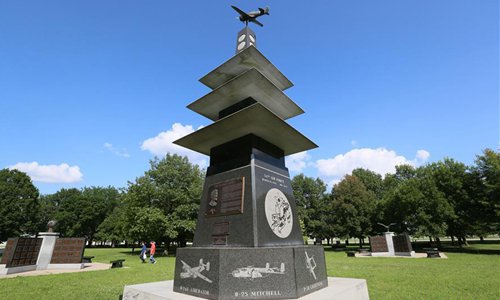
The photo taken on July 24, 2019 shows the monument for the Flying Tigers in the memorial park of the National Museum of the US Air Force in Dayton, Ohio, the United States. The Flying Tigers, a US air squadron composed of pilots from the United States Army Air Corps, Navy, and Marine Corps, helped the Chinese fight Japanese invaders in World War II. The National Museum of the US Air Force displays more than 360 aircrafts and thousands of historical items that bring history to life. In its World War II Gallery, many exhibits reveal a memorable part of China-US cooperation when the two countries joined hands in fighting fascism and safeguarding world peace. (Xinhua/Zhang Fengguo)

People view the Curtiss P-40E Warhawk used by the Flying Tigers in the World War II Gallery of the National Museum of the US Air Force in Dayton, Ohio, the United States, on July 24, 2019. The Flying Tigers, a US air squadron composed of pilots from the United States Army Air Corps, Navy, and Marine Corps, helped the Chinese fight Japanese invaders in World War II. The National Museum of the US Air Force displays more than 360 aircrafts and thousands of historical items that bring history to life. In its World War II Gallery, many exhibits reveal a memorable part of China-US cooperation when the two countries joined hands in fighting fascism and safeguarding world peace. (Xinhua/Zhang Fengguo)

Visitors view the silver goblets representing 80 heroic Doolittle raiders in the World War II Gallery of the National Museum of the US Air Force in Dayton, Ohio, the United States, on July 24, 2019. Four months after the Japanese attack on Pearl Harbor, a group of 80 US airmen named after their mission commander Jimmy Doolittle volunteered to retaliate. Most of them were later rescued by voluntary Chinese civilians and troops. Recent researches from the US side have estimated that up to 250,000 Chinese people lost their lives because they helped Doolittle Raiders. The National Museum of the US Air Force displays more than 360 aircrafts and thousands of historical items that bring history to life. In its World War II Gallery, many exhibits reveal a memorable part of China-US cooperation when the two countries joined hands in fighting fascism and safeguarding world peace. (Xinhua/Zhang Fengguo)
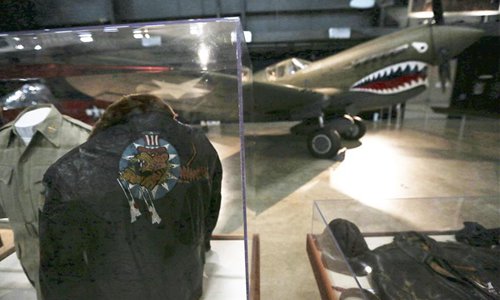
Items of Flying Tigers are on display in the World War II Gallery of the National Museum of the US Air Force in Dayton, Ohio, the United States, on July 24, 2019. The Flying Tigers, a US air squadron composed of pilots from the United States Army Air Corps, Navy, and Marine Corps, helped the Chinese fight Japanese invaders in World War II. The National Museum of the US Air Force displays more than 360 aircrafts and thousands of historical items that bring history to life. In its World War II Gallery, many exhibits reveal a memorable part of China-US cooperation when the two countries joined hands in fighting fascism and safeguarding world peace. (Xinhua/Zhang Fengguo)
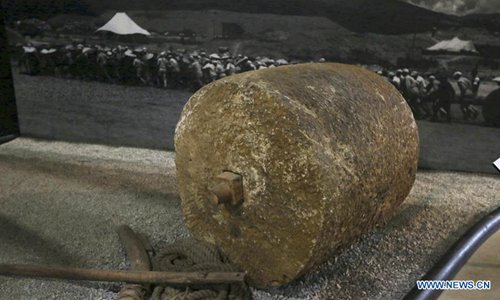
A Chinese stone roller is on display in the World War II Gallery of the National Museum of the US Air Force in Dayton, Ohio, the United States, on July 24, 2019. During World War II, thousands of Chinese workers used hand-hewn stone rollers to construct airfields throughout China to support Allied offensive air operations and the airlift of vital supplies into China. The National Museum of the US Air Force displays more than 360 aircrafts and thousands of historical items that bring history to life. In its World War II Gallery, many exhibits reveal a memorable part of China-US cooperation when the two countries joined hands in fighting fascism and safeguarding world peace. (Xinhua/Zhang Fengguo)
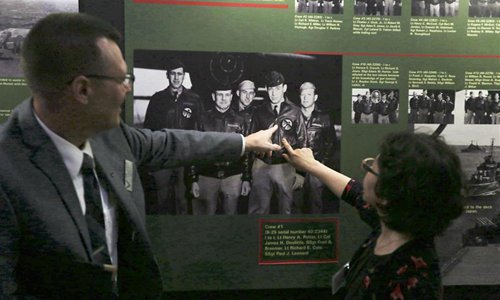
People point to photos of Doolittle raiders exhibited in the World War II Gallery of the National Museum of the US Air Force in Dayton, Ohio, the United States, on July 24, 2019. Four months after the Japanese attack on Pearl Harbor, a group of 80 US airmen named after their mission commander Jimmy Doolittle volunteered to retaliate. Most of them were later rescued by voluntary Chinese civilians and troops. Recent researches from the US side have estimated that up to 250,000 Chinese people lost their lives because they helped Doolittle Raiders. The National Museum of the US Air Force displays more than 360 aircrafts and thousands of historical items that bring history to life. In its World War II Gallery, many exhibits reveal a memorable part of China-US cooperation when the two countries joined hands in fighting fascism and safeguarding world peace. (Xinhua/Zhang Fengguo)
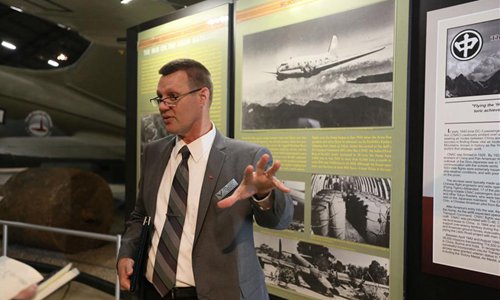
Dr. Douglas Lantry, curator and historian of the National Museum of the US Air Force, introduces the story about the Hump in the World War II Gallery of the National Museum of the US Air Force in Dayton, Ohio, the United States, on July 24, 2019. The Hump, or the "death route" over the Himalayan mountains, was operated jointly by China and the United States from 1942 to 1945 to transport military supplies from India to Southwest China. The National Museum of the US Air Force displays more than 360 aircrafts and thousands of historical items that bring history to life. In its World War II Gallery, many exhibits reveal a memorable part of China-US cooperation when the two countries joined hands in fighting fascism and safeguarding world peace. (Xinhua/Zhang Fengguo)